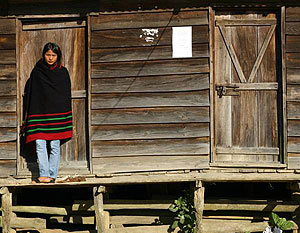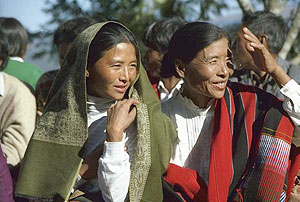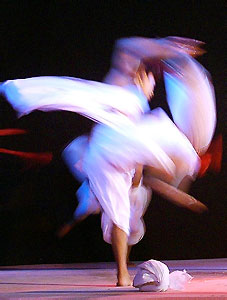|
|
|
Manipur |
|
|
Information about Manipur
Manipur literally means a jeweled land. Manipur is
situated in the northeastern part of India. This town is
nestled deep within a lush green corner of the north
east India and surrounded by blue hills with an oval
shaped valley at the centre. Manipur is bordered in the
north by Nagaland, in the east by Myanmar (Burma), in
the south by Mizoram, and in the west by Assam. It seems
much like an exquisite work of art executed by superb
hands of nature and is indeed a state of exquisite
natural beauty and splendors. Manipur is rich in art,
culture and tradition and surcharged with nature's
pristine glory. Mrs. Lord Irwin, British Viceroy and
Governor General of India, described Manipur as the
“Switzerland of India”. St. Clair Grimwood also
described it as "a pretty place more beautiful than many
show places of the world" and Late Pandit Jawaharlal
Nehru described it as "Jewel of India". The capital of
Manipur is Imphal. The Raasleelas |
|
|
|
and the
classical dance of Manipur hold a very significant position in
the cultural map of India. The climate of Manipur varies from
the tropical to sub-alpine types. The summer months here are
moderately hot and the winters are comfortable. Manipuri,
English, Hindi are the main languages which are spoken in
Manipur. |
|
|
|
History of
Manipur
Manipur was an ancient kingdom. It is mentioned in the
Mahabharata. Arjuna, the third Pandava brother, had married
the princess of Manipur and had subsequently suffered defeat
at the hands of his son Babrubahan. Manipur was always
independent of its neighboring tribal areas. Over the
centuries the Manipuris had battles for the suzerainty of
Manipur with Burma. Manipur was often invaded by Burma, and
enjoyed long and stable governments for a good time. In 1826,
Manipur became a part of British India following the Yandaboo
treaty with the East India Company on February 24, 1826. This
treaty was an agreement at the end of the Indo-Burmese war
that established the sovereignty of the British government.
Manipur came under the British rule as a princely state after
the defeat in the Anglo-Manipuri War of 1891. During the World
War II, the Japanese forces marched to Manipur. Imphal was
also under siege by the India National Army in World War II
and part of it was captured. A revolt in Manipur later led to
the |
|
hanging
of Maharaja’s brother. In 1930, there was one more
attempt at freedom from the British. A self-styled
prophet, Jodonang who announced the imminent departure
of the British, was hanged. Another young freedom
fighter, Rani Gaidiniliou, then aged 17, was sentenced
to life imprisonment. She was released by Jawaharlal
Nehru after independence and honoured. After
independence of India in 1947, the princely state of
Manipur was merged in the Indian Union on October
15,1949 and became a full-fledged state of India on the
21st January, 1972 with a Legislative Assembly of 60
seats, out of which 20 are reserved for Scheduled Tribe
and 1 is reserved for Scheduled Caste. The State is
represented in the Lok Sabha by two |
 |
|
|
members and
by one member in the Rajya Sabha. Manipuri was recognized as
one of the national languages in 1992.
Geography
of Manipur
Much of Manipur lies above 2000 m. However, the heart of the
populated area is a low lying basin. In its centre is the
reedy Loktak Lake and the flat bottom basin and river valleys
that drain into it are extremely beautiful. There are several
large lakes in the central area where the rivers drawn
southwards. They are used for fishing, duck shooting and
special boat races. |
|
|
|
People of Manipur
The people of Manipur are reputed to be fierce warriors.
They excel in martial arts like spear dance, sword
fights and wrestling. They are also excellent riders.
The people here are very polite and hospitable. Polo,
the sport that spread over the Mughal empire in the 16th
century before becoming international through the
British, originated in Manipur. They also enjoy dancing.
The majority of the people are Hindus and worshippers of
Lord Vishnu. They belong to the Meithe tribe and are
related to the Shans of Burma, who live in the valleys.
The hill tribes who constitute about a third |
 |
|
|
of the
population are mainly Christians. These tribals live not far
from the capital, some 60 km. to the north-east. The area is
restricted due to occasional insurgency.
Festivals
of Manipur
The festivals of Manipur hold special importance to the people
of the state. Most of their festivals are characterized by
traditional dance and music and refreshment. The Yaosang
festival is celebrated on the full-moon day of March. This
festival is celebrated to welcome the spring season. There are
various other festivals like the Cheirouba, the Manipuri New
Year and Ningol Chakaouba. The festival to reassure the loving
relationship of the siblings is known as Ningol Chakaouba. Kut
is another festival that marks the harvesting season in
Manipur. Feasts, traditional drinks, and merrymaking are the
main characteristics of the festival. |
|
|
|
Dances of Manipur
The ancient musical forms of the valley dwellers are
closely connected to the worship of Vishnu which are
expressed in the Manipuri School of Indian Dance. The
Rajashree Bhagyachandra created the famous Ras Lila, the
classical dance of Manipur, out of his enchanting dream
by the grace of Lord Krishna. The Rasa Lila dances that
usually adopt a Krishna-Gopi theme are performed at
every ceremony. The 'Sankirtanas' often precede the
Rasa. The Manipur dance is known for its style and
delicacy. The tribal ritual dances, some of which are
performed by priests in front of deities are very
different and may end in a trance. The various other
dances that last for several days observe a strict form
and are accompanied by the drone of a bowed instrument
called the "pana".
Cities
in Manipur
Imphal, the capital
of Manipur has a lot to offer to the tourists visiting
this state. The city has two war cemeteries, a museum
displaying tribal arts and crafts, Royal Polo Grounds
and the |
 |
|
|
Raja’s
Palace. Some of the tourist attractions in Imphal are the
Shree Govindajee Temple, Kaina, Khwairamand Bazaar, Manipur
Zoological Garden, the beautiful Loktak Lake and Sendra
Island. Besides this, Langthabal, Moirang, Moreh, Phubala,
Singda, Khongjom, Sahid Mandir, Khonghampat Orchidarium,
Keibul Lamjao National Park, Sekta Archeological Living
Museum, and the Manipur State Museum are also worth visiting
places in Imphal.
More... |
|